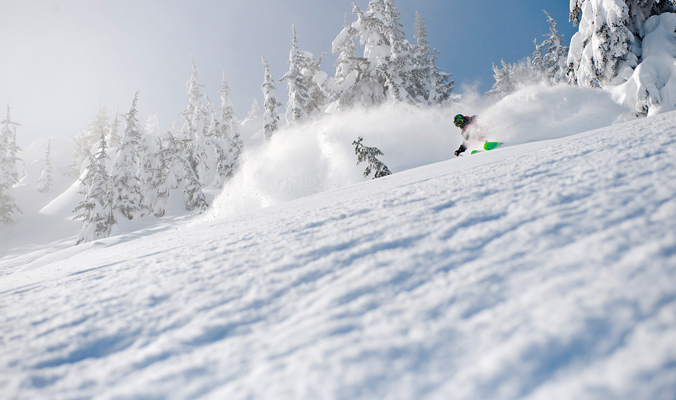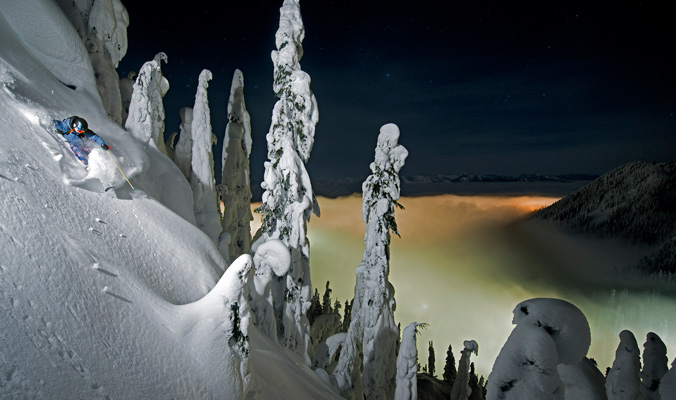Seattle-based photographer Ian Coble is always in search of new challenges, never content with sitting by and letting his career take its course. Coble likes to explore new genres and compositional styles, and his dynamic eye shows through in his diverse body of work.
Recently, Coble spoke with us about his drive to capture new movements on camera and letting each moment speak to him.
Backcountry Magazine: What drew you to photography as a profession?
Ian Coble: I graduated from college [Western Washington University] with an anthropology degree and after graduation was like, “Well, now what am I going to do?” Photography had always been a hobby that I’d had since junior high school and so my roommates [in college] at the time suggested, “Well, why don’t you pick up your camera and take some photos and see if you like that?” I just threw an old SLR in my backpack and skied around with it for a winter. At the end of the winter I took a look at what I had and was like, “Wow! That was really fun.” I had some good images from it and I thought “maybe I can do this for a job.” It snowballed from there. One photo that got published turned into three and then all of a sudden I was doing catalog shoots and ad shoots. That led me to where I am now.
BCM: What is your interest in portraiture versus sport photography?IC: I wanted to keep photography interesting and challenging. That was what originally led me to wanting to split my time [between the two genres]. After having shot skiing for a number of years, shooting someone making a perfect pow turn becomes almost second nature. And it’s still beautiful, it’s still enjoyable, but it’s something where if you have done it a hundred times the challenge becomes more fleeting. If I can capture the essence of who that person really is and show their personality through a portrait, that is another fun part of photography that involves different techniques, new lighting. That was a different challenge that kept photography interesting and still does.
BCM: How have the athletes you have worked with influenced your style?
IC: One of the things that drew me to ski photography was the relationships that you have with people. The athletes you are working with are also your peers. They are people who I have skied with for a decade or more. They are your friends, your family. You really do bond with those people over the shared beauty of the experiences that you get to come across.
BCM: What are some of the challenges you face as an action sports photographer?
IC: The ski industry is not one that has huge budgets to work with, so it is constantly an uphill battle of trying to push to have sustainable, livable wages. That’s always a challenge because you always get the argument from clients, “you are doing this for the passion of it.” That is very true, but at the same time, it takes complete dedication to this sport and this industry in order to make a living off of it.
BCM: How do you define your photographic style?
IC: I always try and have everything about my photos be very crisp and clean. I try to let the moment be its own moment instead of trying to force it because of this predetermined style that I have or a preset way that I want it to look. It’s letting each situation—whether it’s portrait or a line in the backcountry—it’s letting that place speak and been seen. I try to capture the vibe or mood that is there.
As far as my photography goes, it has changed since I first picked up a camera. It is an ongoing evolution of my eye, of my technique, of what is important to me and the way I see things.
BCM: What is the most spectacular thing you didn’t catch on camera?IC: There was one [instance] where I was driving from Bellingham to Seattle when I was first getting into photography and there was a Russian space station that had broken apart and was entering the Earth’s atmosphere. It looked like a bunch of UFOs coming into the atmosphere; the whole sky was lit up. And I actually went so far as stop and pull over and I was furiously scrambling to get to my camera bag and get my camera and tripod out. As soon as I got it put together, it has dissipated away. I was kind of like, “Damn it! No one is going to believe this happened.”
BCM: What was the transition like from ski photography to your sport portraiture?
IC: It was a reeducation. When everyone starts their career as a photographer, their first few years are really slow because no one knows who you are. You have an unknown style. You might have really beautiful images, but at first the people who are hiring you aren’t willing to trust that unknown entity, regardless of how pretty those photos are. So transitioning from skiing to also including the non-gravity sports stuff was like learning to walk all over again. It’s learning a new industry; it’s learning a new style. There is a personal sense of accomplishment every time you get a new job or overcome a hurdle. There is a sense of pride in being able to define yourself in more than one industry.
BCM: What is the funniest thing that has happened to you while shooting?
IC: I think the funniest thing that’s happened to me while shooting was a while back, I think in 2008. I was shooting in a pillow zone in the Cascade backcountry. One of the athletes was on top of a pillow line and I was positioned below so I had an angle to capture him popping off the bottom pillow. He dropped the line, popped off the last pillow and skied by me. I continued shooting him as he passed me when I was hit from behind. It was all blurry for about two seconds and then I found myself standing in the snow without my skis on with my camera still in hand. The pillow my athlete had popped off broke loose as one solid piece (about the size of a Volkswagen bus) when he hit it. It had rolled downhill, hitting me.
Another athlete I was shooting, who was standing nearby, saw the entire event. When the pillow broke loose, I had my back to it. It hit me squarely and sent me flying into the air. It knocked my skis off and cartwheeled me into a front flip. Miraculously, I landed squarely on my feet 30 feet downhill from where I had been standing and my camera never left my hand. Aside from a sore back, I was totally unscathed. Once the adrenaline wore off, none of us could stop laughing.
—
For more on Ian Coble, visit iancoble.com.












What does the photographer mean by saying that shooting a “perfect pow turn” becomes “second nature”?